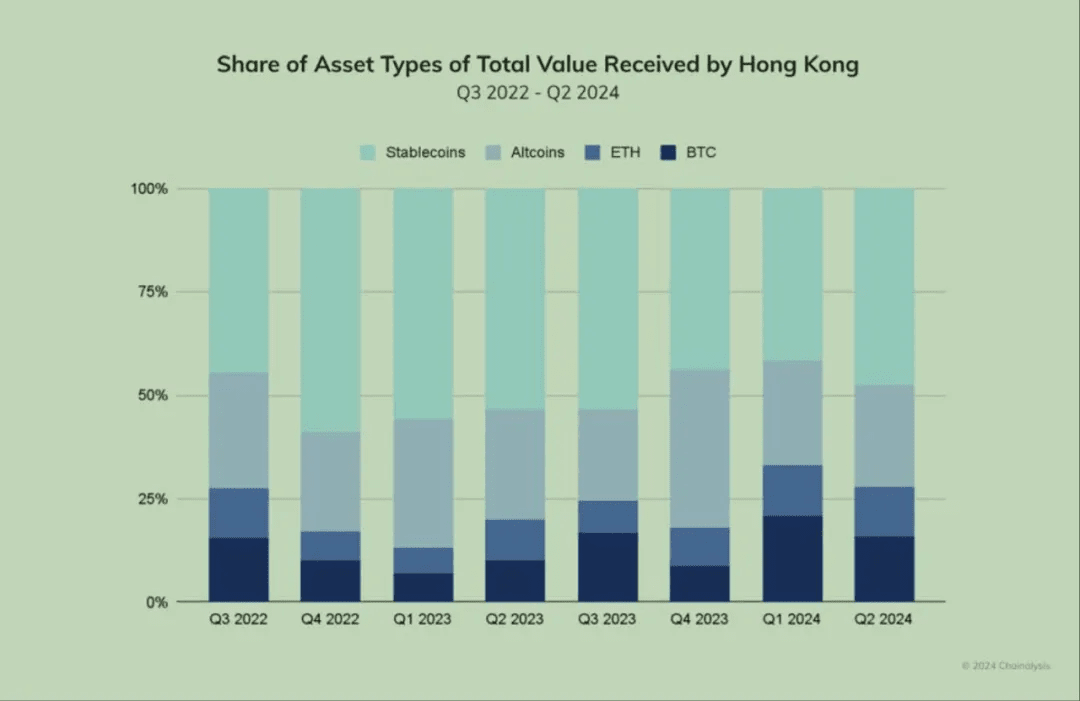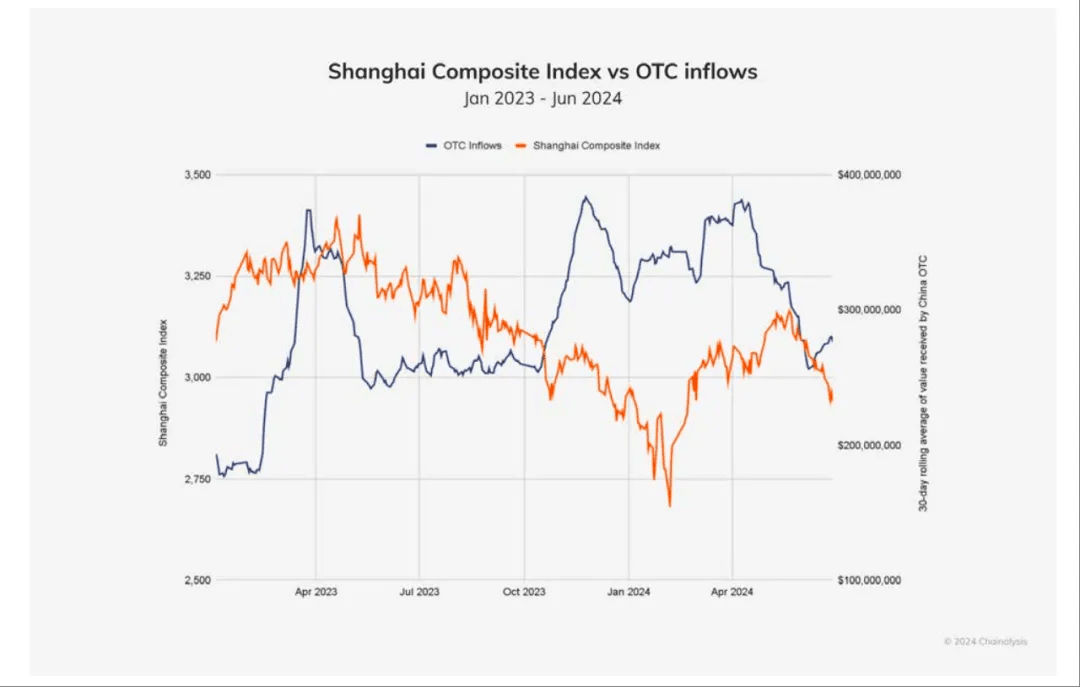In recent months, stablecoins have absolutely become the hottest topic in the financial and cryptocurrency circles! The United States and Hong Kong have successively passed legislation supporting stablecoins, with internet giants and established financial institutions getting involved, either hoarding coins or applying for licenses, as if spring has suddenly arrived, with thousands of pear trees blooming. In contrast, mainland China currently shows no signs of loosening policy, giving a feeling of being firmly seated on a fishing platform. Among this, news of stablecoins being used on a large scale in Yiwu has spread widely online, citing primarily two sources: Huatai Securities research report shows stablecoins have become an important tool for cross-border payments in Yiwu, and blockchain analysis company Chainalysis estimates that the on-chain stablecoin flow in the Yiwu market will exceed $10 billion in 2023.
Interestingly, when reporters conducted field research, most merchants stated they had not heard of stablecoins and did not understand them; a few merchants expressed doubts about the compliance and costs of stablecoins, and only a very few merchants clearly stated that they had used stablecoins for payments. The situation on the ground felt somewhat like an old man downstairs answering Charlotte 'What is horse something Mei?' 'Horse East something' 'What is something winter Mei?' in a mystical manner. What is the real situation? Let's dig into the two sources of news.
Huatai Securities Research Report
Based on public information, I have not found specific names and sources of the Huatai Securities research report attached by the media. However, with the help of friends, I found a macro securities research report released by Huatai Securities on June 25, titled 'How Will Stablecoins Affect the Global Monetary System?' In this 31-page report, Huatai Securities systematically elaborates on the development prospects and risks of stablecoins globally across eight chapters. On page 8 of the report, there is a statement regarding the use cases of stablecoins:
Aside from being directly used in transactions involving crypto assets, the proportion of stablecoins in global commodity and service transactions, as a means of value storage, and the penetration rate among residents are all developing rapidly. Specifically, in Yiwu, the world’s small commodity center, stablecoins have become an important tool for cross-border payments. Blockchain analysis company Chainalysis estimates that the on-chain stablecoin flow in the Yiwu market will exceed $10 billion in 2023.
However, unlike other viewpoints in the report that are supported by data charts, this viewpoint does not have data support attached.
Overall, the report is still highly readable, and here are some selected viewpoints from me:
1. Countries represented by the US (dollar hegemony), EU (single market), and China (potential market) that have a large money supply and stronger legislative push have a huge market size for stablecoins; countries represented by South Korea, which have a developed digital and virtual economy, and those represented by Singapore, which have a high degree of openness and strong reliance on external markets, will have a high penetration rate of stablecoins; countries represented by emerging market economies such as Turkey, Argentina, and Nigeria, which have low currency stability, undeveloped banking systems, a large underground economy, and restricted or sanctioned capital flows, will also have a high penetration rate of stablecoins.
2. In the face of challenges brought by the development of stablecoins, major economies usually adopt two approaches: issuing digital currencies or strengthening regulations on stablecoins. For mainland China, research on digital currencies began as early as 2014, and a pilot program was launched in 2019. With the rapid development of stablecoins, especially the stablecoin legislation in Hong Kong set to take effect this August, it may mark China's shift towards a 'dual-track' development path. The central bank governor's speech at the Lujiazui Forum on June 18 this year also clearly stated that emerging technologies such as blockchain and distributed ledgers are driving the robust development of central bank digital currencies and stablecoins, indicating that the People's Bank of China is placing increased importance on stablecoins.
3. Hong Kong's stablecoin legislation is expected to accelerate the development of the HKD, offshore RMB, and even RMB stablecoins, providing further impetus for the appreciation of the RMB. Expanding the 'funding pool' for HKD and offshore RMB, enriching high liquidity assets such as interest rate bonds that can be invested, vigorously developing cross-border business, digital economy, virtual economy, and increasing the usage scenarios of stablecoins, are key measures for the success of Hong Kong’s stablecoin, and will once again reactivate the process of RMB internationalization.
4. Stablecoins pose challenges to cross-border financial regulation while facing a certain degree of redemption risk. When the value of reserve assets fluctuates, the credit of the issuing entity is challenged, or even the issuing entity goes bankrupt, fiat-backed stablecoins may also become unmoored in value. As the scale of stablecoins expands and their impact on the traditional financial system deepens, it may ultimately require accepting stricter regulations, or even partial nationalization, in exchange for genuine stability.
Data analysis by Chainalysis
Unfortunately, through searches on domestic and foreign websites, I have not found relevant statements or data support regarding Yiwu merchants' use of stablecoins in the 2023 and 2024 (Cryptocurrency Geography Report) released by Chainalysis.
I have also extracted some data and views from Chainalysis reports regarding mainland China and Hong Kong:
1. For a long time, the proportion of stablecoins in the value of crypto assets received by Hong Kong users has remained above 40%, and with the stablecoin legislation in Hong Kong set to officially take effect this August, it is expected that this proportion will further increase.

2. Data indicates that Chinese users utilize crypto assets to preserve and increase the value of their wealth.

In my view, whether stablecoins will be used on a large scale in Yiwu may lack accurate data verification, but the combination of foreign trade and stablecoins does have inherent advantages. The characteristics of stablecoin payments, such as instant settlement, stable value, and low fees, address many pain points for small and medium-sized foreign trade merchants.
On the other hand, considering the regulatory policies in mainland China regarding stablecoins and other crypto assets, mainland foreign trade merchants face significant compliance issues when directly using stablecoins in transactions, and there is even a potential risk of criminal liability.
Moreover, considering that the current export tax rebate policy in China often requires providing bank settlement slips, using stablecoins would mean that this documentation cannot be provided, thus missing out on export tax rebates, which is fatal for merchants' profits. On the other hand, qualifications for exhibitions such as the Canton Fair typically consider the bank transaction records of exporting companies as an important reference standard, and commercial banks' lending review standards also place importance on the bank transaction records of exporting companies. These factors determine that, for now, the scale of stablecoin usage among Yiwu exporters will not be significant.
So, how can foreign trade merchants in mainland China compliantly use stablecoins to reduce costs and increase efficiency? Currently, a relatively compliant way is to leverage the connection between Hong Kong companies and mainland companies, utilizing Hong Kong's trade facilitation and open policies towards crypto assets to achieve compliant integration of traditional foreign trade and crypto payments.
HKD stablecoins and feasible compliant foreign trade models using stablecoins.
On August 1, the Hong Kong (Stablecoin Regulation) will officially take effect, and the Hong Kong government will begin accepting applications for licenses to issue stablecoins in Hong Kong. This means that stablecoins recognized by the Hong Kong authorities will officially go live, with HKD stablecoins being regarded as legal payment methods, and exchanges between HKD stablecoins and fiat currencies will also become more convenient and compliant.
1. The rigid requirement for 100% redemption of HKD stablecoins.
The Hong Kong (Stablecoin Regulation) stipulates that stablecoin issuers must ensure that their issued stablecoins have sufficient reserve assets to support them, ensuring that the market value of the reserve assets is not less than the face value of the issued circulating stablecoins.
Stablecoin issuers must ensure that holders have the right to redeem the stablecoins, and they must not obstruct or restrict the redemption of stablecoins, nor charge any fees other than reasonable transaction fees during the redemption process.
2. HKD stablecoins meet compliance requirements for anti-money laundering and anti-terrorist financing.
The Hong Kong (Stablecoin Regulation) requires that the issuers of HKD stablecoins must comply with strict anti-money laundering and anti-terrorist financing requirements.
In a consulting document released by the Hong Kong Monetary Authority on May 26, the authority outlined related anti-money laundering and anti-terrorist financing requirements, which include:
Customer due diligence. For transactions of purchasing or redeeming that reach or exceed a baseline of HKD 8000, customers must undergo due diligence, including verifying wallet ownership.
Strict regulation of non-custodial wallets. Implement strict monitoring and transaction limits on non-custodial wallet transactions to reduce the risk of wallets being exploited by criminals;
Continuous monitoring. Use blockchain analysis to track transaction history and detect illegal activities, reporting suspicious transaction activities;
Conduct due diligence on custodial wallet providers;
Blacklist illegal wallet addresses.
3. Key points for mainland foreign trade merchants to compliantly utilize HKD stablecoins.
Considering the current policy differences between mainland China and Hong Kong regarding stablecoins, I believe that mainland foreign trade merchants can avoid most compliance risks by grasping the following three key points when utilizing HKD stablecoins:
Utilizing Hong Kong or other offshore company entities to receive and pay stablecoins;
The compliant exchange of stablecoins and fiat currencies is completed in Hong Kong;
Compliant conversion of fiat currency back to the mainland parent company;
Mainland foreign trade enterprises can compliantly utilize stablecoins through Hong Kong companies to conduct foreign trade business. Consultation and交流 are welcome.
Source: Saul Goodman SAUL, Author: Lawyer Deron Lu Wenlong.
